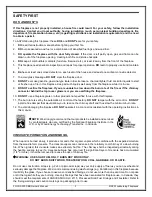
FOCUS 320 SBR Owner's Manual
10
RSF Woodburning Fireplaces
Take the time to poke and stir the unburnt wood that is left in the firebox. This will help revive the fire. Place the
new logs in the firebox. Try to maintain a clear path in front of the pilot, which is the metal tube centered between
the two andiron posts. The pilot brings an influx of air close to the coals that will help to keep the fire going. Once
the new wood has been loaded, keep the door slightly ajar for about 3-10 minutes to get the fire going depending
on how well seasoned your cordwood is and how much coals were left in the firebox. Once the new wood it well lit,
close the door.
Wait at least 15 minutes after shutting the door after reloading before turning any blowers back on. This ensures
that heat will built up in the firebox before being cooled by the blower and ensures that your fireplace will continue
on burning as clean as it can.
TROUBLESHOOTING PROBLEMS
If smoke comes into the house when the door is opened:
•
You may have opened the door too quickly and created a suction of air into the room, this can be avoided by
opening the door more slowly.
•
Ensure your chimney is clean and your chimney cap is not plugged. Chimney caps with screens are more likely
to become clogged with creosote buildup.
•
Make sure you have adequate chimney height for your system. Refer to the Chimney section of this booklet
and make sure to take altitude, and number of elbows into consideration.
•
If you have purchased the central heat kit option or the circulating internal blower, make sure the blower is off
before opening the door.
•
Check to see if other fans in the home are running, particularly a kitchen range hood, or bathroom exhaust fan.
This can affect the pressure in the home.
•
Try opening a window near the fireplace a little, this will equalize the pressure in the home and should correct
a draft problem. Once proper draft is established the window can be closed.
•
Make sure you’ve used enough kindling to establish a hot fire quickly. The most likely time that smoke will enter
the home is during the lighting process.
If your fireplace burns excessively fast, seemingly uncontrollably:
•
Check all door seals and gaskets to ensure that air is not leaking into the firebox. See “Door Adjustment” for
details of how to verify the tightness of the door.
•
Inspect the secondary air tubes in the top of the fireplace to ensure they are in good condition. An unwanted
hole in the secondary air tubes can bring additional unwanted air into the fireplace.
MAINTENANCE
CHIMNEY CLEANING
Check the chimney for creosote buildup every week or so until experience shows how often you need to clean it. A
buildup of ¼" or more should be cleaned before more creosote accumulates. Close the fireplace door(s) prior to
sweeping. Use an 7" round brush.
We do not recommend moving or removing the baffle for chimney sweeping. The top part of the baffle is a metal
plate that can be easily vacuumed after sweeping the chimney. Be careful not to get too close to the sides and back
of the firebox with the vaccum nozzle. The soft white insulation can be easily torn and swallowed.
Nevertherless, if you prefer to remove the baffle, you will have to remove both side refractory bricks (see the
"Refractory Brick Installation" section for detailed instructions), then remove the front seondar air tube (remove the
cutter-pin on the left) and then the baffle (see "Baffle" section for detailed instructions). Make sure to reinstall
everything correctly after cleaning.











































